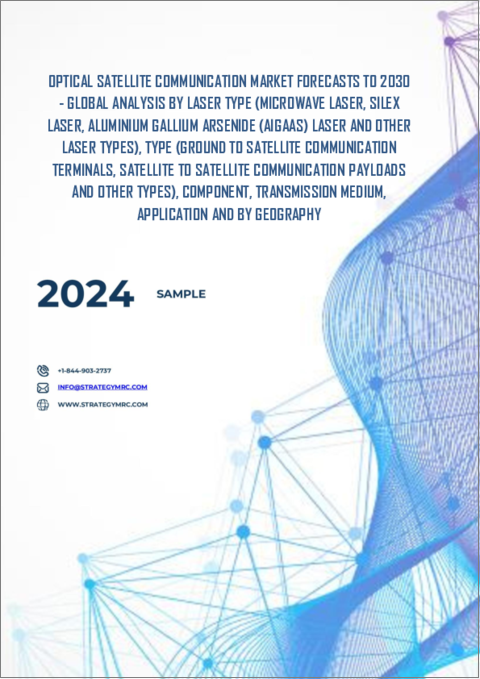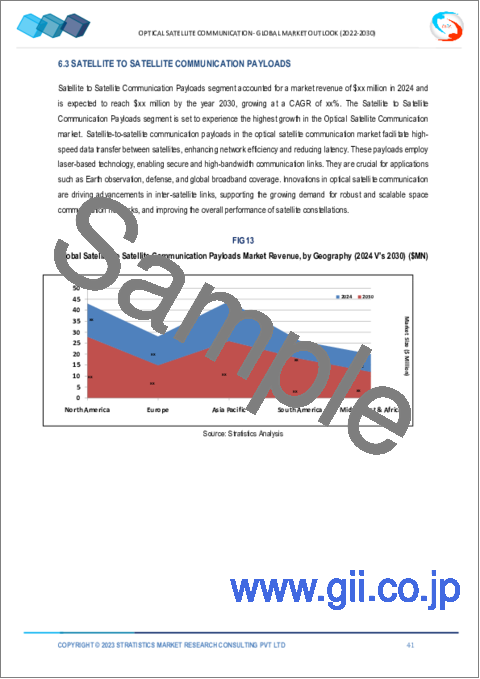|
|
市場調査レポート
商品コード
1446961
光衛星通信市場の2030年までの予測: レーザータイプ別、タイプ別、コンポーネント別、伝送媒体別、用途別、地域別の世界分析Optical Satellite Communication Market Forecasts to 2030 - Global Analysis By Laser Type (Microwave Laser, Silex Laser, Aluminium Gallium Arsenide Laser and Other Laser Types), Type, Component, Transmission Medium, Application and By Geography |
||||||
カスタマイズ可能
|
|||||||
| 光衛星通信市場の2030年までの予測: レーザータイプ別、タイプ別、コンポーネント別、伝送媒体別、用途別、地域別の世界分析 |
|
出版日: 2024年03月03日
発行: Stratistics Market Research Consulting
ページ情報: 英文 200+ Pages
納期: 2~3営業日
|
全表示
- 概要
- 図表
- 目次
Stratistics MRCによると、世界の光衛星通信市場は2023年に18億米ドルを占め、予測期間中のCAGRは18.4%で成長し、2030年には58億米ドルに達すると予測されています。
光衛星通信市場は、光技術を利用した衛星通信システムの開発、展開、利用を包含する産業を指します。この技術は、より高いデータ転送速度、帯域幅の拡大、セキュリティの強化を提供します。また、通信分野では、光衛星通信は効率的で高速な接続を促進し、世界な通信ネットワークを強化します。
宇宙技術の進歩
衛星の設計、製造、配備における絶え間ない進歩は、高度な通信システムの統合に拍車をかけ、光衛星通信は最先端のソリューションとして台頭してきました。こうした技術的進歩には、衛星の小型化、電力効率の向上、より洗練された光学部品の開発などが含まれます。さらに、宇宙技術の向上により、より小型で機敏な衛星に光通信システムを組み込むことが可能になり、費用対効果の高い配備と運用能力の向上が促進されています。
物理的障害物に対する脆弱性
従来の無線周波数通信とは異なり、光信号は衛星と地上局との間の直接見通し線に依存します。建物、山、その他の障害物などの物理的な障害物は、この見通し線を妨げ、通信リンクを中断し、信号伝送に影響を与える可能性があります。この制限は、特に起伏の多い地形や多数の建造物がある都市景観を特徴とする地域において、一貫した接続性を確立・維持する上で課題となります。しかし、光信号に障害物のない経路が必要なため、地上局を戦略的に配置し、衛星軌道を慎重に検討する必要があるかもしれないです。
衛星配備の増加
通信、地球観測、ナビゲーションなど、さまざまな分野で衛星を利用したサービスの需要が高まるにつれ、効率的なデータ交換を促進する高度な通信技術が必要とされています。より高速のデータ転送レートと広帯域を提供できる光衛星通信は、拡大する衛星エコシステムの通信要件を満たす上でますます重要になっています。さらに、小型衛星、コンステレーション、メガコンステレーションの急増は、衛星と地上局間のデータトラフィックの急増を管理する光通信の重要性をさらに強調しています。
信号傍受のリスク
光衛星通信は、従来の無線周波数システムと比べてセキュリティ機能が強化されているとはいえ、傍受やハッキングの脅威から完全に免れる通信技術はないです。データ伝送をレーザーベースの信号に依存しているため、強固な暗号化プロトコルと高度なセキュリティ対策の確立が不可欠です。サイバー脅威の絶え間ない進化は、高度な攻撃に対する光通信システムの脆弱性を懸念させ、伝送中の機密データを危険にさらす可能性があります。
COVID-19の影響:
ロックダウンや移動制限時の遠隔通信や接続ソリューションに対する需要の高まりは、光技術を含む堅牢な衛星通信システムの必要性を高めています。遠隔作業、オンライン教育、遠隔医療の急増は、信頼性の高い高速通信ネットワークの重要性を浮き彫りにし、高度な衛星通信への関心を高めています。しかし、パンデミックは、世界・サプライ・チェーンの混乱、配備スケジュールの遅延、投資決定に影響を及ぼす財政的制約などの課題も突きつけています。様々な業界における景気後退は、設備投資への慎重なアプローチを促し、光衛星通信のような新しい先端技術の採用を鈍らせる可能性があります。
予測期間中、変調器セグメントが最大になる見込み
予測期間中、変調器セグメントが最大シェアを占める。光通信システムの主要コンポーネントは、デジタルデータを光信号にエンコードして伝送するのに役立っています。高度な電気光学変調器や音響光学変調器の開発など、変調器設計の技術的進歩は、より効率的な変調・復調プロセスを可能にすることで市場の拡大に貢献しています。さらに、これらの進歩は光衛星通信システムの全体的な性能を高め、より高速で信頼性の高いデータ伝送を可能にします。
予測期間中、地球観測分野のCAGRが最も高くなると予想されます。
地球を監視し理解することにますます重点が置かれるようになり、地球観測分野は予測期間中に最も高いCAGRを示すと予想されています。光衛星通信は、地球観測衛星から地上局への大量の高解像度画像およびセンシングデータの伝送を、より効率的かつ高速に行うことを可能にします。この能力は、環境モニタリング、農業、災害管理、都市計画などのアプリケーションに不可欠です。
最大のシェアを占める地域:
アジア太平洋地域は、急速な経済発展と相まって高度な通信技術に対する需要が急増しており、宇宙ベースのインフラへの投資を促進しているため、予測期間中最大のシェアを占めると予測されています。さらに、アジア太平洋地域の宇宙産業における戦略的イニシアティブやコラボレーションが市場の勢いに貢献しています。さらに、光衛星通信のような高度通信技術の研究開発および実装は、これらのプロジェクトによって資金提供されることが多いです。協力を促進するため、この地域の多くの国が宇宙機関を設立または拡大しています。民間企業の参入も、通信・宇宙産業における競争と技術革新の火付け役となっています。
CAGRが最も高い地域:
北米地域は、予測期間中に収益性の高い成長を遂げると予測されます。ピア・ツー・ピアのビデオ・オン・デマンドやオーディオ・オン・デマンドのようなマルチメディア・サービスの人気が高まるにつれて、高いネットワーク帯域幅が必要とされます。光衛星通信は信頼性が高く、手頃な料金で大容量のネットワーク帯域幅を提供できるため、この地域の産業は成長しています。さらに、光衛星通信の市場は、急速な都市化、ライフスタイルの変化、支出の急増、個人消費の上昇によってプラスの影響を受けています。これらの要素が地域の成長を後押ししています。
無料のカスタマイズ提供:
本レポートをご購読のお客様には、以下の無料カスタマイズオプションのいずれかを提供させていただきます:
- 企業プロファイル
- 追加市場プレーヤーの包括的プロファイリング(3社まで)
- 主要企業のSWOT分析(3社まで)
- 地域セグメンテーション
- 顧客の関心に応じた主要国の市場推計・予測・CAGR(注:フィージビリティチェックによる)
- 競合ベンチマーキング
- 製品ポートフォリオ、地理的プレゼンス、戦略的提携に基づく主要企業のベンチマーキング
目次
第1章 エグゼクティブサマリー
第2章 序文
- 概要
- ステークホルダー
- 調査範囲
- 調査手法
- データマイニング
- データ分析
- データ検証
- 調査アプローチ
- 調査ソース
- 1次調査ソース
- 2次調査ソース
- 前提条件
第3章 市場動向分析
- 促進要因
- 抑制要因
- 機会
- 脅威
- 用途分析
- 新興市場
- 新型コロナウイルス感染症(COVID-19)の影響
第4章 ポーターのファイブフォース分析
- 供給企業の交渉力
- 買い手の交渉力
- 代替品の脅威
- 新規参入業者の脅威
- 競争企業間の敵対関係
第5章 世界の光衛星通信市場:レーザーの種類別
- マイクロ波レーザー
- サイレックスレーザー
- アルミニウムガリウムヒ素(AIGaAs)レーザー
- その他
第6章 世界の光衛星通信市場:タイプ別
- 地上対衛星通信端末
- モバイル端末
- 固定端子
- 衛星間通信ペイロード
- 大型衛星
- 小型衛星
- 中型衛星
- その他
第7章 世界の光衛星通信市場:コンポーネント別
- 変調器
- 復調器
- 送信機
- 受信機
- その他
第8章 世界の光衛星通信市場:伝送媒体別
- 衛星間リンク
- 無線
- その他
第9章 世界の光衛星通信市場:アプリケーション別
- エンタープライズ接続
- 調査と宇宙探査
- 通信
- 地球観測
- その他
第10章 世界の光衛星通信市場:地域別
- 北米
- 米国
- カナダ
- メキシコ
- 欧州
- ドイツ
- 英国
- イタリア
- フランス
- スペイン
- その他欧州
- アジア太平洋地域
- 日本
- 中国
- インド
- オーストラリア
- ニュージーランド
- 韓国
- その他アジア太平洋地域
- 南米
- アルゼンチン
- ブラジル
- チリ
- その他南米
- 中東とアフリカ
- サウジアラビア
- アラブ首長国連邦
- カタール
- 南アフリカ
- その他中東とアフリカ
第11章 主な発展
- 契約、パートナーシップ、コラボレーション、合弁事業
- 買収と合併
- 新製品の発売
- 事業拡大
- その他の主要戦略
第12章 企業プロファイル
- Analytical Space, Inc
- ATLAS Space Operations, Inc
- BridgeSat Inc
- Hisdesat Servicios Estrategicos, S.A
- Laser Light Communications
- Maxar Technologies
- Mynari AG
- SITAEL S.p.A.
- Surrey Satellite Technology
- Tesat-Spacecom GmbH & Co. KG
- Thales Alenia Space
List of Tables
- Table 1 Global Optical Satellite Communication Market Outlook, By Region (2021-2030) ($MN)
- Table 2 Global Optical Satellite Communication Market Outlook, By Laser Type (2021-2030) ($MN)
- Table 3 Global Optical Satellite Communication Market Outlook, By Microwave Laser (2021-2030) ($MN)
- Table 4 Global Optical Satellite Communication Market Outlook, By Silex Laser (2021-2030) ($MN)
- Table 5 Global Optical Satellite Communication Market Outlook, By Aluminium Gallium Arsenide (AIGaAs) Laser (2021-2030) ($MN)
- Table 6 Global Optical Satellite Communication Market Outlook, By Other Laser Types (2021-2030) ($MN)
- Table 7 Global Optical Satellite Communication Market Outlook, By Type (2021-2030) ($MN)
- Table 8 Global Optical Satellite Communication Market Outlook, By Ground to Satellite Communication Terminals (2021-2030) ($MN)
- Table 9 Global Optical Satellite Communication Market Outlook, By Mobile Terminals (2021-2030) ($MN)
- Table 10 Global Optical Satellite Communication Market Outlook, By Fixed Terminals (2021-2030) ($MN)
- Table 11 Global Optical Satellite Communication Market Outlook, By Satellite to Satellite Communication Payloads (2021-2030) ($MN)
- Table 12 Global Optical Satellite Communication Market Outlook, By Large Satellites (2021-2030) ($MN)
- Table 13 Global Optical Satellite Communication Market Outlook, By Small Satellites (2021-2030) ($MN)
- Table 14 Global Optical Satellite Communication Market Outlook, By Medium Satellites (2021-2030) ($MN)
- Table 15 Global Optical Satellite Communication Market Outlook, By Other Types (2021-2030) ($MN)
- Table 16 Global Optical Satellite Communication Market Outlook, By Component (2021-2030) ($MN)
- Table 17 Global Optical Satellite Communication Market Outlook, By Modulator (2021-2030) ($MN)
- Table 18 Global Optical Satellite Communication Market Outlook, By Demodulator (2021-2030) ($MN)
- Table 19 Global Optical Satellite Communication Market Outlook, By Transmitters (2021-2030) ($MN)
- Table 20 Global Optical Satellite Communication Market Outlook, By Receivers (2021-2030) ($MN)
- Table 21 Global Optical Satellite Communication Market Outlook, By Other Components (2021-2030) ($MN)
- Table 22 Global Optical Satellite Communication Market Outlook, By Transmission Medium (2021-2030) ($MN)
- Table 23 Global Optical Satellite Communication Market Outlook, By Intersatellite Links (2021-2030) ($MN)
- Table 24 Global Optical Satellite Communication Market Outlook, By Wireless (2021-2030) ($MN)
- Table 25 Global Optical Satellite Communication Market Outlook, By Other Transmission Mediums (2021-2030) ($MN)
- Table 26 Global Optical Satellite Communication Market Outlook, By Application (2021-2030) ($MN)
- Table 27 Global Optical Satellite Communication Market Outlook, By Enterprise Connectivity (2021-2030) ($MN)
- Table 28 Global Optical Satellite Communication Market Outlook, By Research and Space Exploration (2021-2030) ($MN)
- Table 29 Global Optical Satellite Communication Market Outlook, By Telecommunication (2021-2030) ($MN)
- Table 30 Global Optical Satellite Communication Market Outlook, By Earth Observation (2021-2030) ($MN)
- Table 31 Global Optical Satellite Communication Market Outlook, By Other Applications (2021-2030) ($MN)
Note: Tables for North America, Europe, APAC, South America, and Middle East & Africa Regions are also represented in the same manner as above.
According to Stratistics MRC, the Global Optical Satellite Communication Market is accounted for $1.8 billion in 2023 and is expected to reach $5.8 billion by 2030 growing at a CAGR of 18.4% during the forecast period. The Optical Satellite Communication Market refers to the industry that encompasses the development, deployment, and utilization of satellite communication systems utilizing optical technology. This technology offers higher data transfer rates, increased bandwidth, and enhanced security. Additionally, in the telecommunications sector, optical satellite communication facilitates efficient and high-speed connectivity, enhancing global communication networks.
Market Dynamics:
Driver:
Advancements in space technology
Continuous progress in satellite design, manufacturing, and deployment has spurred the integration of advanced communication systems, with optical satellite communication emerging as a cutting-edge solution. These technological strides encompass improvements in satellite miniaturization, power efficiency, and the development of more sophisticated optical components. Furthermore, enhanced space technology enables the incorporation of optical communication systems into smaller and more agile satellites, facilitating cost-effective deployments and improved operational capabilities.
Restraint:
Vulnerability to physical obstructions
Unlike traditional radio-frequency communication, optical signals rely on a direct line of sight between satellites and ground stations. Physical obstructions such as buildings, mountains, or other obstacles can impede this line of sight, disrupting the communication link and affecting signal transmission. This limitation poses challenges in terms of establishing and maintaining consistent connectivity, particularly in geographies characterized by rugged terrain or urban landscapes with numerous structures. However, the need for unobstructed paths for optical signals may necessitate strategic placement of ground stations and careful consideration of satellite orbits.
Opportunity:
Increasing satellite deployments
As the demand for satellite-based services grows across diverse sectors, including telecommunications, Earth observation, and navigation, there is a corresponding need for advanced communication technologies to facilitate efficient data exchange. Optical satellite communication, with its capability to provide higher data transfer rates and enhanced bandwidth, becomes increasingly crucial in meeting the communication requirements of the expanding satellite ecosystem. Additionally, the proliferation of small satellites, constellations, and mega-constellations further underscores the significance of optical communication in managing the surge in data traffic between satellites and ground stations.
Threat:
Risk of signal interception
While optical satellite communication offers enhanced security features compared to traditional radio-frequency systems, no communication technology is entirely immune to potential interception or hacking threats. The reliance on laser-based signals for data transmission makes it imperative to establish robust encryption protocols and advanced security measures. The continuous evolution of cyber threats raises concerns about the vulnerability of optical communication systems to sophisticated attacks, potentially compromising sensitive data during transmission.
Covid-19 Impact:
The increased demand for remote communication and connectivity solutions during lockdowns and travel restrictions has bolstered the need for robust satellite communication systems, including optical technologies. The surge in remote work, online education, and telemedicine has underscored the importance of reliable and high-speed communication networks, driving interest in advanced satellite communication. However, the pandemic has also posed challenges, such as disruptions in the global supply chain, delayed deployment schedules, and financial constraints affecting investment decisions. The economic downturn in various industries has prompted a cautious approach to capital expenditures, potentially slowing down the adoption of new and advanced technologies like optical satellite communication.
The modulator segment is expected to be the largest during the forecast period
Modulator segment dominated the largest share over the forecast period. Key components in optical communication systems, are instrumental in encoding digital data onto optical signals for transmission. Technological advancements in modulator designs, such as the development of sophisticated electro-optic and acousto-optic modulators, contribute to the market's expansion by enabling more efficient modulation and demodulation processes. Furthermore, these advancements enhance the overall performance of optical satellite communication systems, allowing for faster and more reliable data transmission.
The earth observation segment is expected to have the highest CAGR during the forecast period
With an increasing emphasis on monitoring and understanding our planet, Earth Observation segment is expected to have the highest CAGR during the forecast period. Optical satellite communication enables the transmission of large volumes of high-resolution imaging and sensing data from Earth Observation satellites to ground stations with greater efficiency and speed. This capability is vital for applications such as environmental monitoring, agriculture, disaster management, and urban planning.
Region with largest share:
Asia Pacific region is projected to hold largest share over the projected period as the region's burgeoning demand for advanced communication technologies, coupled with rapid economic development, has propelled investments in space-based infrastructure. Additionally, strategic initiatives and collaborations in the space industry across the Asia Pacific region contribute to the market's momentum. Additionally, research, development, and implementation of advanced communication technologies, such as optical satellite communication, are often funded by these projects. To promote collaboration, a number of the region's nations have created or expanded their space agencies. The participation of private sector businesses has also sparked competition and innovation in the communication and space industries.
Region with highest CAGR:
North America region is projected to witness profitable growth over the extrapolated period. High network bandwidth is required as multimedia services like peer-to-peer video-on-demand and audio-on-demand grow in popularity. The industry in the region is growing because optical satellite communication is more dependable and can offer large amounts of network bandwidth at affordable rates. Additionally, the market for optical satellite communication is positively impacted by rapid urbanization, changes in lifestyle, a spike in expenditures and rising consumer spending. These elements are boosting the regional growth.
Key players in the market
Some of the key players in Optical Satellite Communication market include Analytical Space, Inc, ATLAS Space Operations, Inc, BridgeSat Inc, Hisdesat Servicios Estrategicos, S.A, Laser Light Communications, Maxar Technologies, Mynari AG, SITAEL S.p.A., Surrey Satellite Technology, Tesat-Spacecom GmbH & Co. KG and Thales Alenia Space.
Key Developments:
In March 2023, The European Space Agency (ESA) extended a contract with Surrey Satellite Technology Ltd (SSTL) to provide additional communications services from Lunar Pathfinder, scheduled for launch in 2025. The agreement extends ESA and SSTL's existing commercial lunar service agreement signed in September 2021 and creates new opportunities for low-cost lunar exploration, technology demonstration, and reconnaissance missions.
In July 2022, Ball Aerospace, a Ball Corporation company, celebrated with NASA and all mission partners as NASA's James Webb Space Telescope shared its first images with the world. The Colorado-based company designed and built the advanced optical technology and lightweight mirror system that make these unprecedented images possible.
In March 2022, BridgeComm, a leader in Optical Wireless Communications (OWC) solutions and services, announced they are collaborating with Space Micro, Inc., powered by Voyager Space, for a 24-month development contract for advanced one-to-many optical communications from the Space Development Agency (SDA).
Laser Types Covered:
- Microwave Laser
- Silex Laser
- Aluminium Gallium Arsenide (AIGaAs) Laser
- Other Laser Types
Types Covered:
- Ground to Satellite Communication Terminals
- Satellite to Satellite Communication Payloads
- Other Types
Components Covered:
- Modulator
- Demodulator
- Transmitters
- Receivers
- Other Components
Transmission Mediums Covered:
- Intersatellite Links
- Wireless
- Other Transmission Mediums
Applications Covered:
- Enterprise Connectivity
- Research and Space Exploration
- Telecommunication
- Earth Observation
- Other Applications
Regions Covered:
- North America
- US
- Canada
- Mexico
- Europe
- Germany
- UK
- Italy
- France
- Spain
- Rest of Europe
- Asia Pacific
- Japan
- China
- India
- Australia
- New Zealand
- South Korea
- Rest of Asia Pacific
- South America
- Argentina
- Brazil
- Chile
- Rest of South America
- Middle East & Africa
- Saudi Arabia
- UAE
- Qatar
- South Africa
- Rest of Middle East & Africa
What our report offers:
- Market share assessments for the regional and country-level segments
- Strategic recommendations for the new entrants
- Covers Market data for the years 2021, 2022, 2023, 2026, and 2030
- Market Trends (Drivers, Constraints, Opportunities, Threats, Challenges, Investment Opportunities, and recommendations)
- Strategic recommendations in key business segments based on the market estimations
- Competitive landscaping mapping the key common trends
- Company profiling with detailed strategies, financials, and recent developments
- Supply chain trends mapping the latest technological advancements
Free Customization Offerings:
All the customers of this report will be entitled to receive one of the following free customization options:
- Company Profiling
- Comprehensive profiling of additional market players (up to 3)
- SWOT Analysis of key players (up to 3)
- Regional Segmentation
- Market estimations, Forecasts and CAGR of any prominent country as per the client's interest (Note: Depends on feasibility check)
- Competitive Benchmarking
- Benchmarking of key players based on product portfolio, geographical presence, and strategic alliances
Table of Contents
1 Executive Summary
2 Preface
- 2.1 Abstract
- 2.2 Stake Holders
- 2.3 Research Scope
- 2.4 Research Methodology
- 2.4.1 Data Mining
- 2.4.2 Data Analysis
- 2.4.3 Data Validation
- 2.4.4 Research Approach
- 2.5 Research Sources
- 2.5.1 Primary Research Sources
- 2.5.2 Secondary Research Sources
- 2.5.3 Assumptions
3 Market Trend Analysis
- 3.1 Introduction
- 3.2 Drivers
- 3.3 Restraints
- 3.4 Opportunities
- 3.5 Threats
- 3.6 Application Analysis
- 3.7 Emerging Markets
- 3.8 Impact of Covid-19
4 Porters Five Force Analysis
- 4.1 Bargaining power of suppliers
- 4.2 Bargaining power of buyers
- 4.3 Threat of substitutes
- 4.4 Threat of new entrants
- 4.5 Competitive rivalry
5 Global Optical Satellite Communication Market, By Laser Type
- 5.1 Introduction
- 5.2 Microwave Laser
- 5.3 Silex Laser
- 5.4 Aluminium Gallium Arsenide (AIGaAs) Laser
- 5.5 Other Laser Types
6 Global Optical Satellite Communication Market, By Type
- 6.1 Introduction
- 6.2 Ground to Satellite Communication Terminals
- 6.2.1 Mobile Terminals
- 6.2.2 Fixed Terminals
- 6.3 Satellite to Satellite Communication Payloads
- 6.3.1 Large Satellites
- 6.3.2 Small Satellites
- 6.3.3 Medium Satellites
- 6.4 Other Types
7 Global Optical Satellite Communication Market, By Component
- 7.1 Introduction
- 7.2 Modulator
- 7.3 Demodulator
- 7.4 Transmitters
- 7.5 Receivers
- 7.6 Other Components
8 Global Optical Satellite Communication Market, By Transmission Medium
- 8.1 Introduction
- 8.2 Intersatellite Links
- 8.3 Wireless
- 8.4 Other Transmission Mediums
9 Global Optical Satellite Communication Market, By Application
- 9.1 Introduction
- 9.2 Enterprise Connectivity
- 9.3 Research and Space Exploration
- 9.4 Telecommunication
- 9.5 Earth Observation
- 9.6 Other Applications
10 Global Optical Satellite Communication Market, By Geography
- 10.1 Introduction
- 10.2 North America
- 10.2.1 US
- 10.2.2 Canada
- 10.2.3 Mexico
- 10.3 Europe
- 10.3.1 Germany
- 10.3.2 UK
- 10.3.3 Italy
- 10.3.4 France
- 10.3.5 Spain
- 10.3.6 Rest of Europe
- 10.4 Asia Pacific
- 10.4.1 Japan
- 10.4.2 China
- 10.4.3 India
- 10.4.4 Australia
- 10.4.5 New Zealand
- 10.4.6 South Korea
- 10.4.7 Rest of Asia Pacific
- 10.5 South America
- 10.5.1 Argentina
- 10.5.2 Brazil
- 10.5.3 Chile
- 10.5.4 Rest of South America
- 10.6 Middle East & Africa
- 10.6.1 Saudi Arabia
- 10.6.2 UAE
- 10.6.3 Qatar
- 10.6.4 South Africa
- 10.6.5 Rest of Middle East & Africa
11 Key Developments
- 11.1 Agreements, Partnerships, Collaborations and Joint Ventures
- 11.2 Acquisitions & Mergers
- 11.3 New Product Launch
- 11.4 Expansions
- 11.5 Other Key Strategies
12 Company Profiling
- 12.1 Analytical Space, Inc
- 12.2 ATLAS Space Operations, Inc
- 12.3 BridgeSat Inc
- 12.4 Hisdesat Servicios Estrategicos, S.A
- 12.5 Laser Light Communications
- 12.6 Maxar Technologies
- 12.7 Mynari AG
- 12.8 SITAEL S.p.A.
- 12.9 Surrey Satellite Technology
- 12.10 Tesat-Spacecom GmbH & Co. KG
- 12.11 Thales Alenia Space





